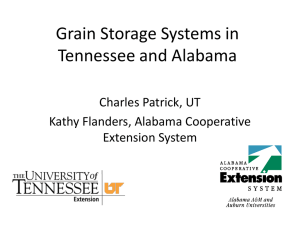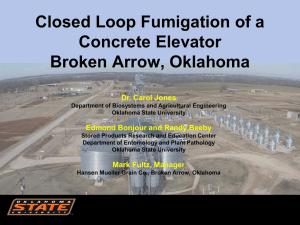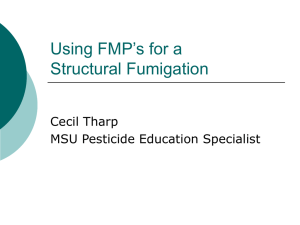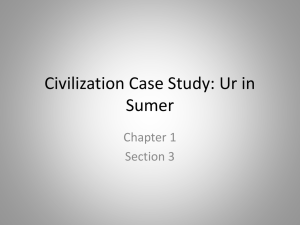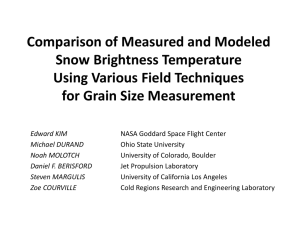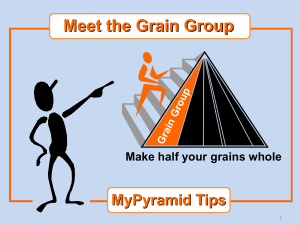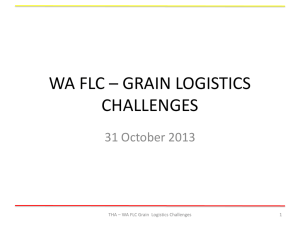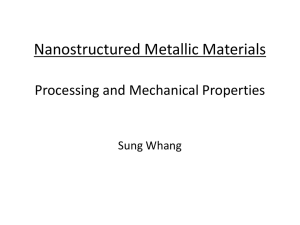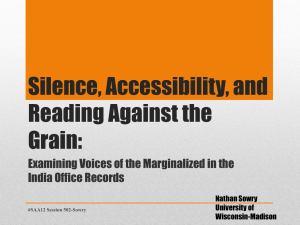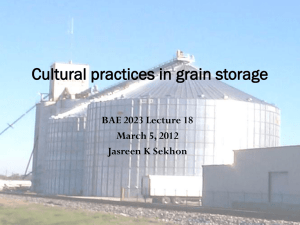Fumigating and Maintenance to Grain Bins
advertisement
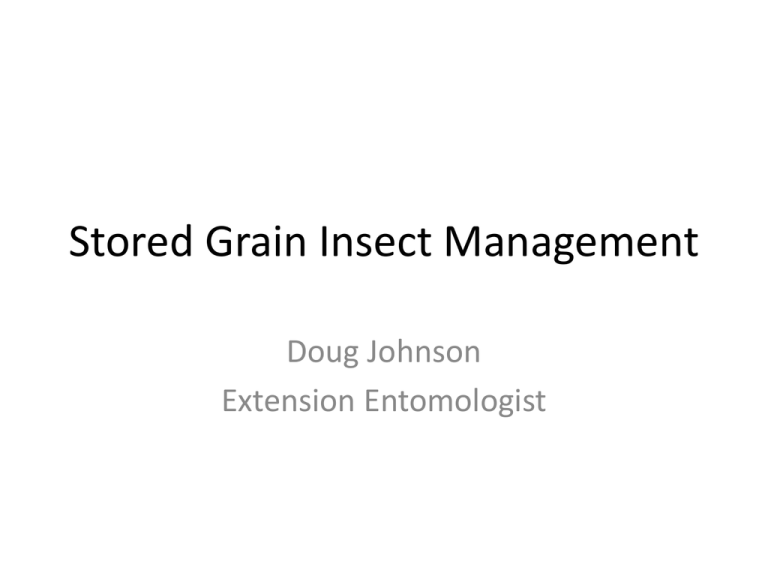
Stored Grain Insect Management Doug Johnson Extension Entomologist General Management Recommendations • • • • • • Clean the bins thoroughly! Fumigate beneath perforated floors Treat the interior and exterior of bins Control Moisture Control Temperature Monitor Insect Activity Secondary Feeders Flour Beetles Rusty Grain Beetle Indian Meal Moth http://en.wikipedia.org/wiki/Indian_meal_moth Lesser Grain Borer in Wheat Primary Feeder Rice Weevil Adult Primary Feeder Rice Weevil Larva Number of granary weevils Number of granary weevils in 80o F wheat at selected intervals starting with 30 insects 12000 10000 8000 6000 4000 2000 0 0 62 82 91 105 Days In a non-limiting environment insect populations increase at an INCREASING rate! 119 178 Number of Insects Growth of insects with all factors equal except starting numbers. 2000 1500 1 10 100 1000 500 0 1 2 3 4 5 Time The starting population size makes a difference! Number of offspring 5 months after 50 pairs of rice weevils placed in wheat Number of Insects 16000 14000 Temperature AND Moisture % Moisture 9% 10% 11% 12% 13% 14% 12000 10000 8000 6000 4000 2000 0 60 70 80 Temperature oF 90 Number of offspring 5 months after 50 pairs of rice weevils placed in wheat Number of Insects 16000 % Moisture Temperature 14000 9% 10% 11% 12% 13% 14% 12000 10000 8000 6000 4000 2000 0 60 70 80 Temperature oF 90 Number of offspring 5 months after 50 pairs of rice weevils placed in wheat Number of Insects 16000 % Moisture Moisture 14000 9% 10% 11% 12% 13% 14% 12000 10000 8000 6000 4000 2000 0 60 70 80 Temperature oF 90 Aeration Controllers Pre-Filling Pesticides • Application under the perforated floor – Fumigation • Application to the interior walls – Liquid – Dust • Application to the exterior walls Number of Insects Growth of insects with all factors equal except starting numbers. 2000 1500 1 10 100 1000 500 0 1 2 3 4 5 Time The starting population size makes a difference! Beetles per Day Number of Flour Beetles per Day Captured in Probe Traps in Wheat in Caldwell Co. KY 2002 250 200 150 100 50 0 Non-Treated Treated 1 3 5 7 9 11 13 15 17 19 Sample Week During Filling • Fumigation during filling – Concentration in the bin? – No residual control – are there insects present? Liquid application to the grain stream -Are there insects present? -Insecticides break down rapidly in a hot bin! Admixture to bulk Grain Empty Bin Actellic Top Dress Field Corn Pop Corn Grain Sorg. Biobit (& others) Soy Wheat Barley Oats Rye Centynal Diacon-D Insecto Sensat Storcide II Tempo 1B.t. Empty Bin Only, May NOT be applied to grain products (Biobit etc.) will control only caterpillars not beetles and is applied to the top 4” of Grain. 2Tempo (cyfluthrin) may not be applied to grain. Insecticides Actellic (Pirimiphos-methyl) (1B) Biobit / Dipel others (Bacillus thuringensis) (11A) Centynal (deltamethrin) (3A) Diacon-D (S-Methoprene) (7A) Insecto (silicon dioxide) Sensat/Contain (Spinosad) (5) Storecide II (deltamethrin (3A)+ chlorprifos-methyl (1B) ) Tempo (cyfluthrin) (3A) Sanitation, Temperature, Moisture Even if you decide to use insecticides…. these three cultural controls will make your insecticides more effective. Monitoring General Recommendations • • • • • • Clean the bins thoroughly! Fumigate beneath perforated floors Treat the interior and exterior of bins Control Moisture Control Temperature Monitor Insect Activity Sanitation, Sanitation, Sanitation Temperature, Temperature, Temperature Moisture, Moisture, Moisture Aeration, Aeration, Aeration How many times do I need so say it? If you only remember one thing! Store Clean Dry Grain In Clean Dry Bins Minimum Exposure Periods for PHOSTOXIN Temperature Pellets Tablets Below 40 degrees F Do Not Fumigate Do Not Fumigate 40 - 53 degrees F 8 days 10 days 54 - 59 degrees F 4 days 5 days 60 - 68 degrees F 3 days 4 days Above 68 degrees F 2 days 3 days Notification Requirements • Authorities and On-Site Workers: As required by local regulations, notify the appropriate local officials (fire department, police department, etc.) of the impending fumigation. Provide to the officials a MSDS and complete label for the product and any other technical information deemed useful. Offer to review this information with the local official(s). • Incidents Involving These Products: Registrants must be informed of any incident involving the use of this product. Please call 1-800-308-4856 or DEGESCH AMERICA, INC. (540) 234-9281/ 1-800-330-2525 so the incident can be reported to Federal and State Authorities. • Theft of Products: Immediately report to the local police department theft of metal phosphide fumigants. RESPIRATORY PROTECTION Gas Concentration Respiratory Protection Less than 0.3 ppm None required 0.3 - 15 ppm (or escape from levels up to 1,500 PPM) NIOSH/MSHA approved full face gas mask - hydrogen phosphide canister combination. More than 15 ppm NIOSH/MSHA approved selfcontained breathing apparatus (SCBA) DRAEGER ACCURO PUMP Fumigation Management Plan • Sec. 21 (of label) REQUIRED WRITTEN FUMIGATION MANAGEMENT PLAN (FMP). • A FMP must be written PRIOR to all applications. • A FMP must be devised to cover application, exposure period, aeration and disposal of the fumigant,… Equipment Needed • Man-in-Bin sign placed near the control panel or auger power control. • 2- or 3-inch tape, spray adhesive, and adhesive for polyethylene sheets. • Applicator’s manual and current label. • • Sufficient fumigant for the volume of the bin. Tape measure to calculate volume of grain to be treated. • 2- to 6-mils polyethylene film large enough to cover the grain surface. Attach a rope to the polyethylene film for easy removal after fumigation. • Cotton gloves for handling phosphine-type fumigant — do not handle tablets with bare hands or wet gloves. • All fumigations should be done by at least two people, each equipped with a full set of safety equipment, including chemical-resistant gloves, protective clothing, etc. • If entrance into the structure is required for fumigating the grain, two licensed people MUST be present. Equipment Needed • Proper respiratory protection for all personnel involved in the fumigation. Check the fumigant label for specific requirements. • Probes for applying aluminum phosphide tablets. • Safety rope to attach to anyone climbing into a bin, and long enough to extend through the bin access point and strong enough so rescue personnel can drag a victim to the exit if necessary. • Shovels to level grain mass prior to treatment. • Grain thermometer to measure grain temperature prior to treatment at locations throughout the grain mass. • Fumigation placards. • A lock to keep unauthorized personnel out of the building. Be sure everyone is out before attaching the lock. • Monitoring equipment to check gas concentration available from the vendors listed at the end of this guide. Successful Fumigation Requires hold the gas in a three dimensional structure Similar to filling a balloon with air. Temperature X Concentration X Time Height Length Width APPLICATOR’S MANUAL FOR PHOSTOXIN® TABLETS AND PELLETS Type of Fumigation 1. Vertical Storages (such as silos, concrete bins, steel bins, etc.) 2. Farm Bins (Butler Type) Dosage Range Pellets Tablets 200-900/1000 bu. 40-180/1000 bu. 150-700/1000 cu.ft. 30-140/1000 cu.ft. 450-900/1000 bu. 350-725/1000 cu.ft. 90-180/1000 bu. 70-145/1000 cu.ft. Cubic feet to be Fumigated Above the grain mass Below the perforated floor SEALING THE BIN 1.) Seal all openings in the bin walls 2.) Cover the grain surface with 4mil plastic, secured at the edges --OR-- 3.) Calculate rate for the entire bin, including the unfilled roof cone. What are we going to do with 300,000 bu. bins? 39’ Phosphine gas penetrates about 25’ 39’ Sam McNeil, University of Kentucky PROTECTIVE CLOTHING Wear dry gloves of cotton or other breathable material if contact with Phostoxin® tablets, pellets or dust is likely. Wear a loose fitting long sleeve shirt, long pants, shoes and socks. After fumigation activities, remove all protective clothing, aerate in a well ventilated area then wash thoroughly, separately, before re-use. If Phostoxin® tablets or pellets become trapped inside clothing, remove clothing, wash hands and exposed skin thoroughly, shower and change into clean clothing. If application of fumigant is performed from within the structure to be fumigated, approved respiratory protection against phosphine must be worn during fumigation, by all personnel in the structure (see below). Distributing the Fumigant Calculate the number of tablets or pellets needed, Deposit them evenly by probing into the grain surface, Probe fumigant in on uniform grid with each probe about four or five feet apart Cover the grain surface with the plastic Attach a line to the plastic to allow removal from outside Depart the bin Seal the bin (lock) The Fumigation Is Not Complete Until The Bin is Clear of Gas!!! • • • • Unseal the bin Open vents, remove plastic cover etc. Operate fans to evacuate residual gas REMEMBER – you must either have gas detection equipment or assume that there is gas remaining in the bin! Important Points to Consider • Fumigants are by far the most toxic products you will ever use. • Fumigations should be preformed by Trained Licensed applicators. • Never fewer than two people. • Phostoxin will explode into fire with direct contact with water. Common Ideas That Will Not Work • Spraying anything through the fan. • Throwing hands full of pellets across the surface of the grain. • Expecting the gas to move more than 30 ft. without circulation. Problem Situation: • Late winter early spring – Temperature of grain, usually too low • Pellets/tablets will not “gas off quickly” enough – Will not reach a control concentration – Pellets/tablets will remain in the grain unspent, until warm enough, so the grain will contain detectable / dangerous amounts of phosphine Problem Situation: Grain remains in a bin that is needed for new crop. • Sell the grain if anyone will take it • Feed the grain to livestock • Fumigate the grain before adding new grain to the bin. • DO NOT store new grain with old grain! What are we going to do with 300,000 bu. bins? 39’ Phosphine gas penetrates about 25’ 39’ Sam McNeil, University of Kentucky

